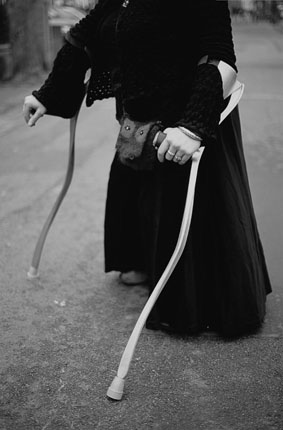Foreword by
Annie Delin
 Aesthetics
and design never seem to be where disabled people want them in the list of priorities.
In architecture and building design, aesthetics so often override function that
access usually gets created as an afterthought, bolted on against the disapproval
of the style-driven architects. Disabled people in public buildings curse and
battle against slippery floors, cavernous acoustics, weighty doors and perspex
signposts – designed for aesthetics, not for function.
Aesthetics
and design never seem to be where disabled people want them in the list of priorities.
In architecture and building design, aesthetics so often override function that
access usually gets created as an afterthought, bolted on against the disapproval
of the style-driven architects. Disabled people in public buildings curse and
battle against slippery floors, cavernous acoustics, weighty doors and perspex
signposts – designed for aesthetics, not for function.
Yet when it comes to the everyday items which disabled people
must have, their clothes, homeware and mobility aids, the exact opposite seems
to apply. We are provided with items that can be easily mass-produced, cleaned
or stacked in a cupboard by a nurse or carer, and not what we would choose to
wear or carry. Aluminium, rubber and a curious bakelite plastic in grey or flesh-tones
are the materials we get handed. The welter of colour, choice and subliminal
pressure applied to the consumer in every other case passes us by.
The message we get is clear – design is not for us. Concepts
like opinion, taste, choice, pleasure and excitement are absent in the provision
made for what we need. A direct opposition is set up between the ideas of "need"
and "want". It is a moral lesson – beggars can’t be choosers,
and disabled people are very evidently cast in the role of beggar.
It wasn’t always so. Social history collections in museums
show us that the moneyed disabled person used to be able to commission craftworks
that served their needs – exquisitely carved wheeled chairs, the candy-twists
of Venetian glass walking canes, hand-embroidered waistcoats which disguised
the bodies of rich men with spinal curvature. Even if you weren’t rich,
before mass-production became ordinary, it would not have been so difficult
to make a jacket that fitted short arms, or a missing limb. Your one pair of
boots would have been made for you, your chair the height you needed to reach
the table.
Disabled people were the cast-offs after standardisation in the
20th century, when difference became bad, and average a word of approval. Manual
crafts and personalisation were marginalised in favour of the ‘one-size-fits-all’
lie. Ergonomics invented an acceptable range of difference around the design
of cars, cookers and school desks, and within which short, fat or one-legged
people didn’t fit. It’s considered shocking in this context to claim
that normality is, in fact, an exception – that most of us are abnormal.
Not far beneath the surface of each collaboration in this exhibition
lie the ghosts of a more responsive past – 500 workmen bending over wooden
benches in a limb-fitting centre, the secret clay pigments of the Arizona desert
which created flesh-toned prostheses, walking sticks which contained brandy
for tedious social events or poisoned darts for your enemies. The artists, makers
and designers involved in adorn, equip have come
to see disabled people as personalities and tried to serve them in a way which
creates not just comfort but the thrill of ownership, fun and status. What’s
new for the 21st Century is the acknowledgment of feelings – of fear and
challenge, insecurity and isolation – which can be addressed with accessories
and aids which are desirable and worth showing off. Their solutions might not
fit in every household – but that’s part of the point. What they offer
is an answer which suits individuals with specific combinations of need, choice,
want and taste – because, guess what? All of these consumer desires exist
in every disabled person who wants to adorn or equip themselves.
Annie Delin is a researcher, journalist,
trainer and disability consultant.
Illustration: Couture Crutches (detail)
by Tim Register with Janie Spencer
© The City Gallery,
Leicester and the artists: 2001
This site was built by Ju
Gosling aka ju90 during an artist's residency at Oriel
31 in November 2001
Return to top of page
 Aesthetics
and design never seem to be where disabled people want them in the list of priorities.
In architecture and building design, aesthetics so often override function that
access usually gets created as an afterthought, bolted on against the disapproval
of the style-driven architects. Disabled people in public buildings curse and
battle against slippery floors, cavernous acoustics, weighty doors and perspex
signposts – designed for aesthetics, not for function.
Aesthetics
and design never seem to be where disabled people want them in the list of priorities.
In architecture and building design, aesthetics so often override function that
access usually gets created as an afterthought, bolted on against the disapproval
of the style-driven architects. Disabled people in public buildings curse and
battle against slippery floors, cavernous acoustics, weighty doors and perspex
signposts – designed for aesthetics, not for function.